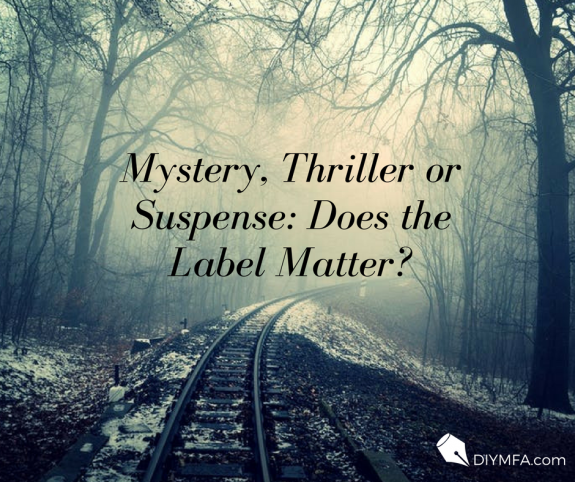When you search for a book to read, do genre labels drive your choices? They certainly affect mine. If I want a fast paced, edge-of-your-seat-experience I look for a thriller. If I’m in a puzzle-solving mood, it’s off to the mystery section. And I expect them all to have elements of suspense.
And yet, on my quest to find the perfect book, I’ve seen the terms suspense and thriller used interchangeably, and instances when mysteries were labeled thrillers.
It made me wonder if there was confusion on how these categories are defined. And what did this mean for me as a writer?
So I sifted through writer websites, author blogs and books in search of the answers. And this is what I discovered:
Mystery is about the puzzle
New York Times bestselling author David Morrell says, “One crucial distinction is that traditional mysteries appeal primarily to the mind and emphasize the logical solution to a puzzle.”
Most of the books I read are mysteries, so this made sense to me. But I wanted more detail so I decided to dig a little deeper.
In her article, The Curious Case of the Appeal of Mystery, Thriller, and Suspense, librarian Becky Spratford writes, “A mystery is a story in which a crime is committed and the “whodunit” and why is unknown until the very end.”
Bestselling crime author Joel Goldman defines it in a slightly different way, “A mystery is built around a secret and usually asks the question “Who?” Something has already happened – a jewel has been stolen, a person has been murdered – and both the reader and hero know about it. The whole novel is dedicated to uncovering who is responsible for that event.”
After seeing these definitions, two of my favorite series came to mind: Michael Connelly’s Harry Bosch and the TV show Law and Order SVU. Harry Bosch is a LAPD homicide detective who solves cases along with the reader. And on Law and Order, we get to follow Detectives Benson and Stabler track down criminals.
Thrillers are about the push and pull between the protagonist and the antagonist
The definition of a mystery seemed pretty clear, so I wondered if the ambiguity was between thriller and suspense. David Morrell says, “Thrillers strive for heightened emotions and emphasize the sensations of what might be called an obstacle race and a scavenger hunt.”
I love a good thriller, that rush of adrenaline when I plunge through the pages. Will Jack be able to save the bus passengers before the villain detonates the bomb (Speed)? Will Nick prove Amy framed him for her disappearance (Gone Girl)? They seem like filmmaking/ literary magic. And as a writer, I wanted to take people on the same heart pounding journey. So I looked for more, a touchstone I could apply to my work.
“In a thriller, a reader usually asks the question ‘How?’ and is propelled through the story by action.” Joel Goldman contends. “Both the reader and the hero of a thriller novel already know who’s responsible for the crime, and both are waiting to see how that criminal will be brought to justice.”
Becky Spratford writes, “A thriller centers on a particular profession such as espionage, law, or medicine. Solving the crime and the puzzle it presents takes a back seat to the jargon of the profession, the potential dangers faced by those involved in it, and the fast-paced, cinematic action of these stories. Thrillers often feature a loner hero who operates under his or her own moral code and the storylines are marked by the cat-and-mouse chase between the hero and villain.”
More of my favorite thrillers come to mind. Lee Child’s Jack Reacher series is an obvious choice. Jack is a modern day vigilante seeking his own version of justice. And of course, the TV show 24. Jack Bauer, a man with his own moral code, fights the clock to stop another terrorist attack.
Have you ever noticed protagonists in thrillers are often named Jack?
Suspense is about tension and what may happen, and can be present in any genre
Suspenseful stories keep me turning the pages. Life is demanding, and I need a reason to keep reading. Don’t you? Writer’s Digest’s Writer’s Encyclopedia says, “Suspense is the element of both fiction and some nonfiction that makes the reader uncertain about the outcome. While most obvious in mystery stories such as those published in Ellery Queen’s Mystery Magazine or Alfred Hitchcock’s Mystery Magazine, suspense is present in all good fiction.”
Best Selling Crime Writer, Libby Fischer Hellman, writes, “Suspense is not so much what is happening, as what may happen. It’s about anticipation, often anticipating the worst. It is about creating an uncertain situation in which the outcome is in doubt. It’s asking a question not immediately answered, raising a concern not immediately addressed, posting a threat not immediately resolved…Suspense depends on stretching time – delaying answers as long as possible.”
And for all the definitions, I discovered that for some authors these labels are secondary.
How Much Do Labels Matter?
Award winning author Steven James believes thriller writing, mystery writing, and literary fiction are all the same. “Simply put, if you don’t hook your readers, they won’t get into the story. If you don’t drive the story forward by making readers worry about your main character, they won’t have a reason to keep reading.”
New York Times Bestselling Author Allison Brennan says “The difference between thrillers and suspense in fiction is primarily marketing. They can be used interchangeably for many books. But one thing that is crucial for any book – but even more important to a thriller/suspense/ mystery – is pacing.”
As a writer, I think these definitions are important because they guide how to structure a novel. Each has distinct elements that must be considered. This becomes even more critical when you look at sub-genres.
Let’s take the cozy mystery as an example. It has its own set of rules and reader expectations that go beyond the mystery genre. New York Times bestselling author Zac Bissonette defines a cozy mystery as “a subgenre of crime fiction that gives readers a chance to delight in vicariously solving a murder—without graphic violence or sex. Protagonists are typically amateur (and usually female) sleuths solving small-town crimes with old-fashioned detective work rather than forensics. These unlikely heroes are often small-business owners who find themselves drawn into detection by crimes impacting their work; sometimes their investigative efforts are aided by a significant other with police connections.”
Joanna Fluke’s Hannah Swensen series is a contemporary example. Hannah is a baker who solves murders in the small town of Lake Eden, Minnesota. The Hallmark channel made this series into several movies.
Romantic Suspense is another complicated category. Much like the name implies, these stories have both elements of romance and suspense. How much of each is frequently debated. This will be a topic in a future column.
So here are the key takeaways:
- Mystery is about the puzzle.
- Thriller is the push and pull between the protagonist and the villain.
- Suspense is about tension and what may happen. It can be present in any genre.
And in the end, nothing is formulaic. It is ultimately about crafting a compelling story with interesting characters. I may select a book because of a genre label, but I keep reading if I’m pulled into the story.
What are your own reader expectations when you look at these categories? And as a writer will these definitions change how you structure and approach your own stories?
 Stacy Woodson is a U.S. Army Special Operations veteran and a self-declared fitness junkie. She loves a good conspiracy story and has penned one of her own. She believes in the power of a good writing community and how it can elevate your writing. She is a contributor to DIY MFA’s 5onFri and a Claymore finalist. She’s represented by John Talbot at the Talbot Fortune Agency.
Stacy Woodson is a U.S. Army Special Operations veteran and a self-declared fitness junkie. She loves a good conspiracy story and has penned one of her own. She believes in the power of a good writing community and how it can elevate your writing. She is a contributor to DIY MFA’s 5onFri and a Claymore finalist. She’s represented by John Talbot at the Talbot Fortune Agency.







